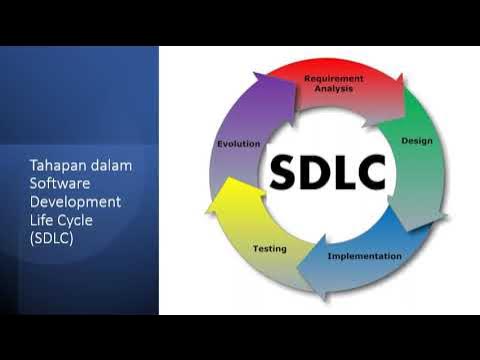5 - Visi dan Cakupan Proyek Perangkat Lunak
Summary
TLDRIn this lecture, Supardianto discusses the importance of Vision and Scope in software requirement analysis. He emphasizes the need for a clear project mission and focus to avoid development disasters. The lecture covers the interaction between Vision and Scope, the role of a business analyst, and managing scope to align with product development goals. It also addresses how to handle scope changes and conflicts, ensuring the final product meets customer needs and expectations.
Takeaways
- 😀 Vision and Scope are crucial for guiding the development process of a software project.
- 🔍 Vision defines the direction and goals of a product, ensuring it aligns with the stakeholders' expectations.
- 📏 Scope specifies the boundaries of the project, detailing what is and isn't included in the current development phase.
- 🤝 Effective communication is necessary to avoid misunderstandings between stakeholders and development teams.
- 🚫 Projects without a clear Vision and Scope can lead to unfocused development and unclear direction.
- 🔄 Inconsistent feature additions and removals can be a sign of poor Vision and Scope management.
- 📈 The Vision should be consistent and not change drastically over time, while Scope can evolve with project versions.
- 🛠️ Scope management involves collecting requirements, defining, planning, verifying, and controlling the project's development.
- 🔄 When new features or requirements are proposed, they should be evaluated against the existing Vision and Scope.
- 💡 If a new feature is promising but outside the current Scope, it can be considered for future development versions.
- 📋 Regularly reviewing and adjusting the Vision and Scope can help prevent conflicts and ensure the project stays on track.
Q & A
What is the importance of defining the Vision and Scope in a project?
-Defining the Vision and Scope is crucial for ensuring the project remains focused and aligned with the desired goals. Without a clear Vision and Scope, the project risks losing direction and becoming unfocused, which could lead to the development of an application or product that doesn't meet the initial objectives or requirements.
What happens when there is a lack of clarity in Vision and Scope during a project?
-When there is a lack of clarity, the project might face issues like inconsistent feature additions or removals. The team may struggle with constantly re-evaluating features, causing delays and misalignment with the product’s goals. This can lead to the development of a product that doesn't meet its intended purpose.
How should the Vision for a product be defined?
-The product Vision should be defined in alignment with the stakeholders' direction. It should reflect the overarching goal of the project and should remain consistent over time, clearly outlining what the product aims to achieve for the customer or client.
What is the role of Scope in project management?
-The Scope defines the specific boundaries of the project, including which tasks and features should be developed within a given time frame. It helps ensure that the project stays on track by prioritizing essential features and setting clear deadlines for each phase of the project.
What are some challenges that can arise from scope creep?
-Scope creep occurs when new features or changes are introduced after the project has started, often causing delays and cost overruns. This can lead to confusion, resource mismanagement, and a final product that does not align with the original Vision and Scope.
How can scope creep be controlled in a project?
-Scope creep can be controlled by constantly referring back to the defined Vision and Scope. If a feature or change request falls outside the original scope, it should be evaluated for future versions, ensuring the current project remains focused and within the agreed-upon parameters.
What should a business analyst do when they receive a new feature request during a project?
-The business analyst should assess whether the requested feature aligns with the project's Vision and Scope. If it’s an essential addition but was overlooked, it can be incorporated. However, if it’s outside the scope, it should be deferred to a future release, ensuring the current project remains focused.
What is the significance of versioning in managing Scope?
-Versioning allows a project to release incremental updates. Features can be prioritized and developed in phases, ensuring that critical features are delivered first while less important ones are planned for future versions, thus managing expectations and maintaining momentum.
What is a business analyst's role when there is a conflict regarding requirements?
-The business analyst’s role is to mediate and help resolve conflicts by validating requirements with stakeholders and project sponsors. They ensure that the proposed changes or features align with the product’s Vision and Scope, and help prioritize features based on the overall project goals.
Why is it necessary to define and maintain the product's Vision and Scope throughout the project?
-Defining and maintaining the Vision and Scope is essential to ensure that the project remains aligned with the stakeholders' expectations and business goals. It provides a framework for decision-making, helps prioritize features, and ensures that the final product meets the intended objectives and customer needs.
Outlines

هذا القسم متوفر فقط للمشتركين. يرجى الترقية للوصول إلى هذه الميزة.
قم بالترقية الآنMindmap

هذا القسم متوفر فقط للمشتركين. يرجى الترقية للوصول إلى هذه الميزة.
قم بالترقية الآنKeywords

هذا القسم متوفر فقط للمشتركين. يرجى الترقية للوصول إلى هذه الميزة.
قم بالترقية الآنHighlights

هذا القسم متوفر فقط للمشتركين. يرجى الترقية للوصول إلى هذه الميزة.
قم بالترقية الآنTranscripts

هذا القسم متوفر فقط للمشتركين. يرجى الترقية للوصول إلى هذه الميزة.
قم بالترقية الآنتصفح المزيد من مقاطع الفيديو ذات الصلة

1 - Pengenalan Analisis dan Spesifikasi Rekayasa kebutuhan

2 - Memahami Stakeholders dan Aktivitas Rekayasa Kebutuhan

Pengantar Rekayasa Perangkat Lunak (Software Engineering)

Information Technology Basic Concepts

Software Requirements Specification (SRS) | Software Engineering

Lecture 08: Waterfall Model
5.0 / 5 (0 votes)
